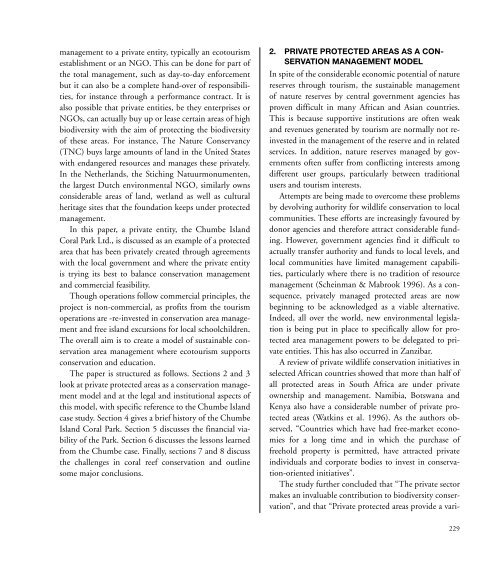You also want an ePaper? Increase the reach of your titles
YUMPU automatically turns print PDFs into web optimized ePapers that Google loves.
management to a private entity, typically an ecotourism<br />
establishment or an NGO. This can be done for part <strong>of</strong><br />
the total management, such as day-to-day enforcement<br />
but it can also be a complete hand-over <strong>of</strong> responsibilities,<br />
for instance through a performance contract. It is<br />
also possible that private entities, be they enterprises or<br />
NGOs, can actually buy up or lease certain areas <strong>of</strong> high<br />
biodiversity with the aim <strong>of</strong> protecting the biodiversity<br />
<strong>of</strong> these areas. For instance, The Nature Conservancy<br />
(TNC) buys large amounts <strong>of</strong> land in the United States<br />
with endangered resources and manages these privately.<br />
In the Netherlands, the Stiching Natuurmonumenten,<br />
the largest Dutch environmental NGO, similarly owns<br />
considerable areas <strong>of</strong> land, wetland as well as cultural<br />
heritage sites that the foundation keeps under protected<br />
management.<br />
In this paper, a private entity, the Chumbe Island<br />
<strong>Coral</strong> Park Ltd., is discussed as an example <strong>of</strong> a protected<br />
area that has been privately created through agreements<br />
with the local government and where the private entity<br />
is trying its best to balance conservation management<br />
and commercial feasibility.<br />
Though operations follow commercial principles, the<br />
project is non-commercial, as pr<strong>of</strong>its from the tourism<br />
operations are -re-invested in conservation area management<br />
and free island excursions for local schoolchildren.<br />
The overall aim is to create a model <strong>of</strong> sustainable conservation<br />
area management where ecotourism supports<br />
conservation and education.<br />
The paper is structured as follows. Sections 2 and 3<br />
look at private protected areas as a conservation management<br />
model and at the legal and institutional aspects <strong>of</strong><br />
this model, with specific reference to the Chumbe Island<br />
case study. Section 4 gives a brief history <strong>of</strong> the Chumbe<br />
Island <strong>Coral</strong> Park. Section 5 discusses the financial viability<br />
<strong>of</strong> the Park. Section 6 discusses the lessons learned<br />
from the Chumbe case. Finally, sections 7 and 8 discuss<br />
the challenges in coral reef conservation and outline<br />
some major conclusions.<br />
2. PRIVATE PROTECTED AREAS AS A CON-<br />
SERVATION MANAGEMENT MODEL<br />
In spite <strong>of</strong> the considerable economic potential <strong>of</strong> nature<br />
reserves through tourism, the sustainable management<br />
<strong>of</strong> nature reserves by central government agencies has<br />
proven difficult in many African and Asian countries.<br />
This is because supportive institutions are <strong>of</strong>ten weak<br />
and revenues generated by tourism are normally not reinvested<br />
in the management <strong>of</strong> the reserve and in related<br />
services. In addition, nature reserves managed by governments<br />
<strong>of</strong>ten suffer from conflicting interests among<br />
different user groups, particularly between traditional<br />
users and tourism interests.<br />
Attempts are being made to overcome these problems<br />
by devolving authority for wildlife conservation to local<br />
communities. These efforts are increasingly favoured by<br />
donor agencies and therefore attract considerable funding.<br />
However, government agencies find it difficult to<br />
actually transfer authority and funds to local levels, and<br />
local communities have limited management capabilities,<br />
particularly where there is no tradition <strong>of</strong> resource<br />
management (Scheinman & Mabrook 1996). As a consequence,<br />
privately managed protected areas are now<br />
beginning to be acknowledged as a viable alternative.<br />
Indeed, all over the world, new environmental legislation<br />
is being put in place to specifically allow for protected<br />
area management powers to be delegated to private<br />
entities. This has also occurred in Zanzibar.<br />
A review <strong>of</strong> private wildlife conservation initiatives in<br />
selected African countries showed that more than half <strong>of</strong><br />
all protected areas in South Africa are under private<br />
ownership and management. Namibia, Botswana and<br />
Kenya also have a considerable number <strong>of</strong> private protected<br />
areas (Watkins et al. 1996). As the authors observed,<br />
“Countries which have had free-market economies<br />
for a long time and in which the purchase <strong>of</strong><br />
freehold property is permitted, have attracted private<br />
individuals and corporate bodies to invest in conservation-oriented<br />
initiatives”.<br />
The study further concluded that “The private sector<br />
makes an invaluable contribution to biodiversity conservation”,<br />
and that “Private protected areas provide a vari-<br />
229


















